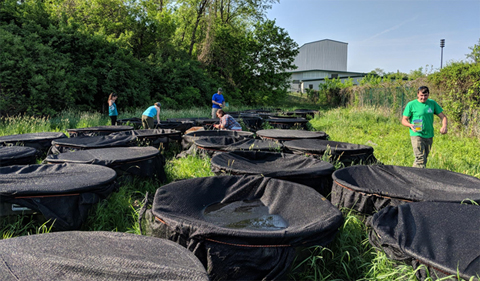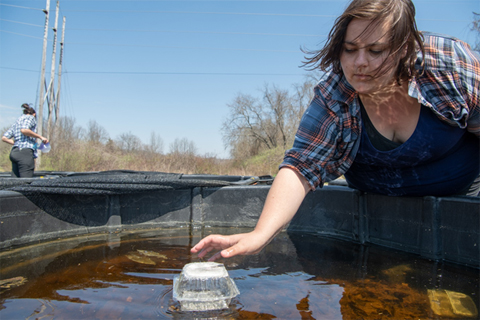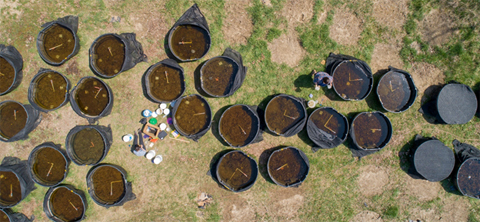
Biological Sciences undergraduate researchers collect data on larval amphibians raised under experimental drought regimes. (photo: Viorel Popescu)
Ohio University researchers were awarded close to $50,000 through the Ohio University 1804 Fund to set up a freshwater research facility that will enable graduate and undergraduate research and experiential learning.
Humans and fish and wildlife alike depend on clean freshwater. Southeastern Ohio is not particularly famous for clean, healthy lakes and streams. Its long history of coal mining, logging and farming has profoundly altered these ecosystems and the structure of communities of organisms that depend on them. Learning more about the functioning of freshwater ecosystems, their resilience and their capacity can guide restoration efforts and planning for safeguarding water resources.
Ohio University is a leader in freshwater ecology and restoration research through its interdisciplinary Appalachian Watershed Research Group. Biological Sciences researchers Dr. Viorel Popescu and Dr. Kelly Johnson, supported by a diverse faculty group from Environmental & Plant Biology, Biological Sciences and Voinovich School of Leadership and Public Affairs, are furthering this research direction by developing a new experimental outdoor Aquatic Mesocosm Facility on the OHIO Athens campus.
The new OHIO Aquatic Mesocosm Facility will take advantage of 40 250-gallon cattle tanks available from Popescu’s Conservation Ecology Lab in Biological Sciences. The 1804 Fund award will be used to set up a perimeter fence to preclude tampering with experiments, build a storage shed for sampling equipment, and provide renewable energy provided by solar-powered batteries.
What is Mesocosm?
What is mesocosm, and how can it advance our understanding of freshwater ecology? In simple terms, a mesocosm is a big tank (typically 150-400 gallons); think for example, a cattle tank that a farmer would use to water livestock. A proper definition of mesocosm is an outdoor experimental system that examines the natural environment under controlled conditions. The “meso” in mesocosm hints at the scale of study systems.
Aquatic mesocosms provide a powerful tool linking “macro” field studies, which are not amenable to experimental manipulation, and “micro” small-scale laboratory experiments, which are often not realistic of the real-world situation.
The large quantity of water contained in a cattle tank mesocosm allows for simulating real-world conditions and manipulating environmental parameters. For example, researchers can test the effect of human impacts on freshwater ecosystems by stocking mesocosms with fish, amphibians or aquatic invertebrates, and changing pH to simulate acid mine drainage, changing water levels to simulate drought, or introducing predators to evaluate behaviors and physiological stress. Graduate research led by Ph.D. student Cassandra Thompson involving mesocosms and funded by the National Science Foundation is ongoing in Popescu’s lab.
Importantly, mesocosms allow for replication of experiments, and reproducibility of research, both fundamental tenets of scientific endeavor. The OHIO facility will join several other mesocosm facilities in Ohio and Midwest, enabling future collaborations.

Biological Sciences Ph.D. student Cassandra Thompson checks experimental mesocosms. Thompson studies the synergies between climate change induced effects and predator exposure on wood frog larvae. (photo: Ben Siegel)
An Outdoor Classroom
In addition to allowing fundamental experimental research, mesocosms are a wonderful and effective teaching tool. Once completed, the mesocosm facility will make an excellent outdoor classroom. This facility, located at West State Street in Athens, is easily accessible to Ohio University students and faculty.
The facility aims to increase student exposure to research across the full range of activities involved in setting up an experiment, monitoring, recording data, data processing and analysis. Faculty will have the opportunity to incorporate sampling and experiments in the curriculum of their courses. Students also will be able to pursue their own research projects as part of a class, or as independent undergraduate research.
For updates on this project and other conservation research at OHIO, follow Viorel Popescu on Twitter @vioreldpopescu.




















Comments